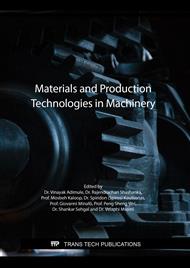[1]
Park, J.J. Kim, Y.H. Fundamental studies on the incremental sheet metal forming technique, Journal of Materials Processing Technology, 140( 1–3) (2000), pp.447-453.
DOI: 10.1016/s0924-0136(03)00768-4
Google Scholar
[2]
Pohlak, M., Majak, J., Kuttner, R. Manufacturability and limitations in incremental sheet forming. Proc. estonian acad. sci. engg. 13(2) (2007) 129-139.
Google Scholar
[3]
Oraon, M., Sharma, V. Sheet metal micro forming: future research potentials. Int. J. on production and industrial engineering 1 (2010) 31-35.
Google Scholar
[4]
Oraon, M., Sharma, V.: Effectiveness of tool profile in sheet metal incremental forming. In: 5th International scientific and expert conference of the international TEAM society, Slovakia 2013; pp.55-59.
Google Scholar
[5]
Lee, J.K., Kinzel, G.L., Wagoner, R. Numerical simulation of 3D sheet metal forming processes, verification of simulations with experiments. In: 3rd International Conference on NUMISHEET 96, the Ohio State University, Dearborn (1994).
Google Scholar
[6]
Guo, Y.Q., Batoz, J.L., Naceur, H., Bouabdallah, S., Mercier, F., Barlet, O. Recent developments on the analysis and optimum design of sheet metal forming parts using a simplified inverse approach, Comput. Struct. 78 (2000) 133–148.
DOI: 10.1016/s0045-7949(00)00095-x
Google Scholar
[7]
Sarraji, W.K.H., Hussain, J., Ren, W. Experimental investigations on forming time in negative incremental sheet metal forming process, Materials and manufacturing processes. 27(5) (2012) 499–506.
DOI: 10.1080/10426914.2011.585550
Google Scholar
[8]
kadhum, A., Zghair H., Mohammed Z. Estimation the influence of tool geometry on the surface quality and tool wear, The iraqi journal for mechanical and material engineering. 10(3) (2010) 417-430.
Google Scholar
[9]
Radu, M.C., Cristea, I. Processing metal sheets by SPIF and analysis of parts quality, materials and manufacturing processes. 28 (2013), 287–293.
DOI: 10.1080/10426914.2012.746702
Google Scholar
[10]
Oraon, M. Statistical analysis to predict the surface roughness in single point incremental forming of Cu67zn33 alloy. International journal of productivity and quality management, 31(4) (2020)593-604.
DOI: 10.1504/ijpqm.2020.111697
Google Scholar
[11]
Podgornik, B., Leskovsek, V. Wear mechanisms and surface engineering of forming tools, Materials and technology. 49(3) (2015) 313–324.
Google Scholar
[12]
Jarfors, A.E.W., Castagne, S.J., Danno, A., Zhang, X. Tool wear and life span variations in cold forming operations and their implications in microforming Technologies, MDPI. 5(3) (2017) 1-29.
DOI: 10.3390/technologies5010003
Google Scholar
[13]
Diabb, J., Rodriguez, C.A., Mamidi, N., Sandoval, J.A., Tijerina, J.T., Romero, O.M., Zuniga, A.E. Study of lubrication and wear in single point incremental sheet forming (SPIF) process using vegetable oil nanolubricants, UDEM. 376-377 (2017), 777–785 (2017).
DOI: 10.1016/j.wear.2017.01.045
Google Scholar
[14]
Lu, B., Fang, Y., Xu, D.K., Chen, J., Ou, H., Moser, N.H., Cao, J. Mechanism investigation of friction-related effects in single point incremental forming using a developed oblique roller-ball tool, International Journal of Machine Tools & Manufacture. 85 (2014) 14–29.
DOI: 10.1016/j.ijmachtools.2014.04.007
Google Scholar
[15]
Grimm, T.J., Ragai, I., Roth, J.T. A novel modification to the incremental forming process, part 2: validation of the multi-directional tooling method, Procedia manufacturing 10 (2017) 520–530.
DOI: 10.1016/j.promfg.2017.07.036
Google Scholar
[16]
Dwivedy, M., Kalluri, V. The effect of process parameters on forming forces in single point incremental forming, Procedia Manufacturing 29 (2019), 120-128.
DOI: 10.1016/j.promfg.2019.02.116
Google Scholar
[17]
Hartmann, C., Volk, W. Knowledge-based incremental sheet metal free-forming using probabilistic density functions and voronoi partitioning, Procedia Manufacturing. 29 (2019), 4-11.
DOI: 10.1016/j.promfg.2019.02.097
Google Scholar
[18]
Dabwan, A., Ragab, A.E., Saleh, M.A. Study of the Effect of Process Parameters on Surface Profile Accuracy in Single-Point Incremental Sheet Forming of AA1050-H14 Aluminum Alloy. International Journal of advances in materials science and engineering, (2020), 1-14.
DOI: 10.1155/2020/7265941
Google Scholar
[19]
Kecman V., Learning and soft computing, MIT Press, Cambridge, (2001).
Google Scholar
[20]
Oraon, M., Sharma, V. Predicting Force in Single Point Incremental Forming by Using Artificial Neural Network. International Journal of Engineering TRANSACTIONS A: Basics, 31(1) 88-95 (2018).
DOI: 10.5829/ije.2018.31.01a.13
Google Scholar
[21]
Oraon, M., Sharma, V. Prediction of Surface Roughness in Single Point Incremental Forming of AA3003-O Alloy Using Artificial Neural Network, International journal of materials engineering Innovation, 9(1) 1-19 (2018).
DOI: 10.1504/ijmatei.2018.10013312
Google Scholar
[22]
Oraon, M., Sharma, V. Application of Artificial Neural Network: A Case of Single Point Incremental Forming (SPIF) of Cu67Zn33 Alloy. Management and Production Engineering Review, 12(1) (2021) 17-23.
Google Scholar
[23]
Davim, J.P., Gaitonde, V.N., Karnik, S.R. Investigations into the effect of cutting conditions on surface roughness in turning of free machining steel by ANN models. J Mater Process Technol. 205 (2008) 16–23.
DOI: 10.1016/j.jmatprotec.2007.11.082
Google Scholar
[24]
Ambrogio G., Cozza, V., Filice, L. and Micari F. An analytical model for improving precision in single point incremental forming. Journal of Materials Processing Technology. 191 (2007) 92-95.
DOI: 10.1016/j.jmatprotec.2007.03.079
Google Scholar
[25]
Ali, S.M., Dhar, N.R. Tool Wear and Surface Roughness Prediction using an Artificial Neural Network (ANN) in Turning Steel under Minimum Quantity Lubrication (MQL)International Journal of Mechanical and Mechatronics Engineering. 4(2) (2010) 250-159.
Google Scholar
[26]
Vahdati M., Sedighi M., Mahdavinejad R. Prediction of applied forces in incremental sheet metal forming (ISMF) process by means of artificial neural network (ANN). Journal of Automotive and Applied Mechanics, 2 (2014).
Google Scholar
[27]
Varthini R., Gandhinathan R., Pandivelan C., Jeevanantham, A.K. Modelling and optimization of process parameters of The single point incremental forming of aluminium 5052 alloy sheet using genetic algorithm-back Propagation neural network. International Journal of Mechanical And Production Engineering, 2 (2014); pp.55-62.
Google Scholar
[28]
Kant, G., Sangwan, K.S. Predictive Modelling and Optimization of Machining Parameters to Minimize Surface Roughness using Artificial Neural Network Coupled with Genetic Algorithm. Procedia CIRP 31 ( 2015 ) 453- 458.
DOI: 10.1016/j.procir.2015.03.043
Google Scholar



